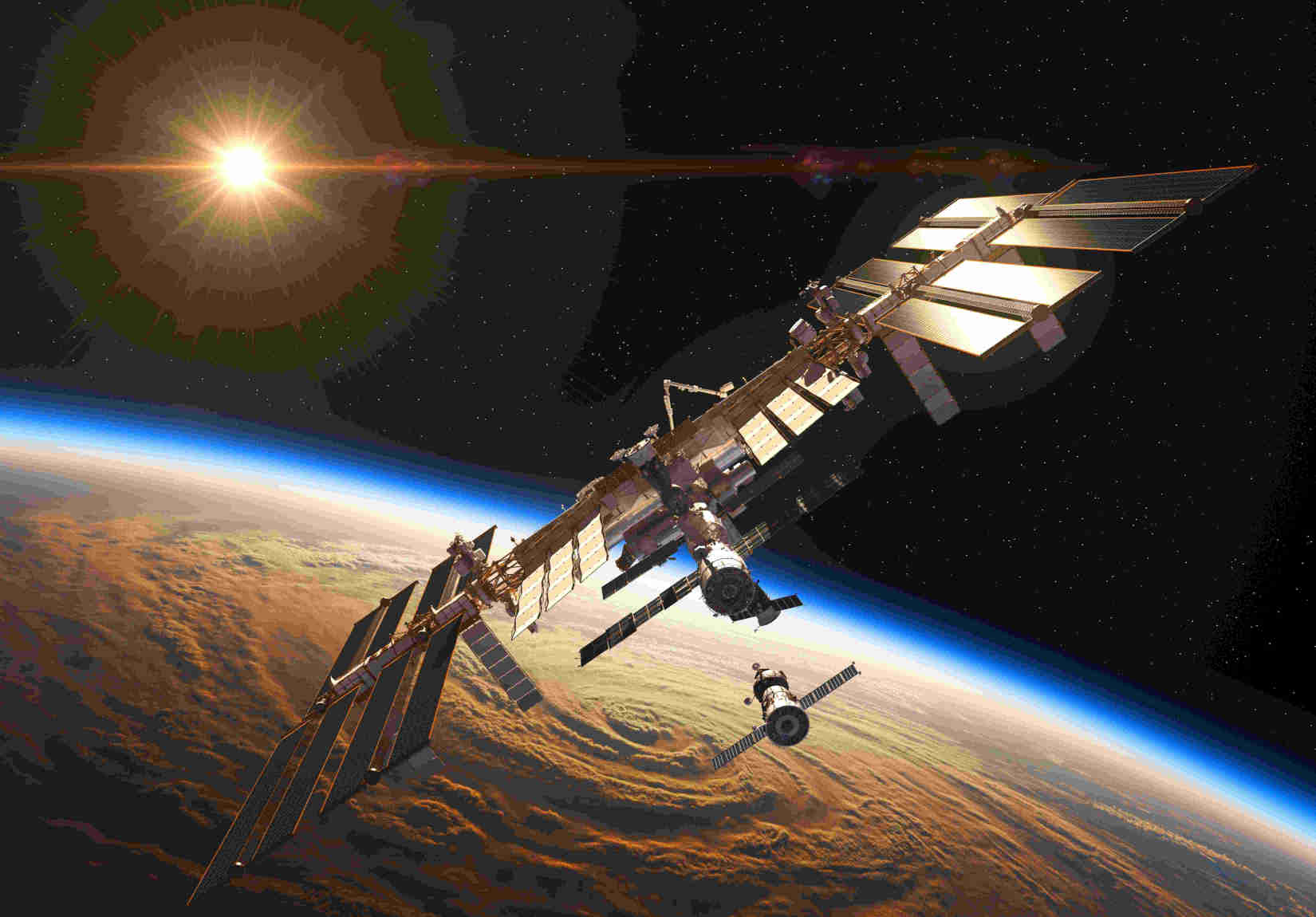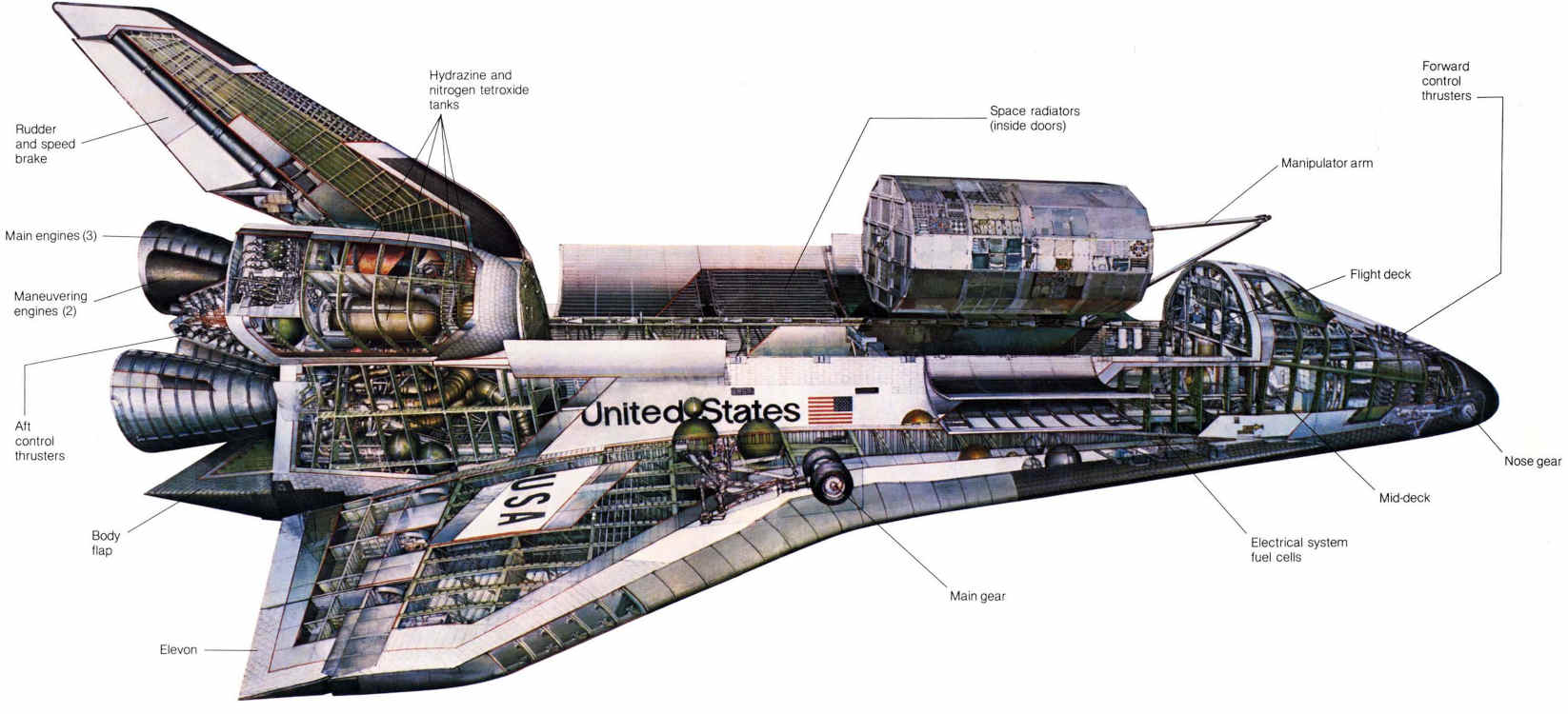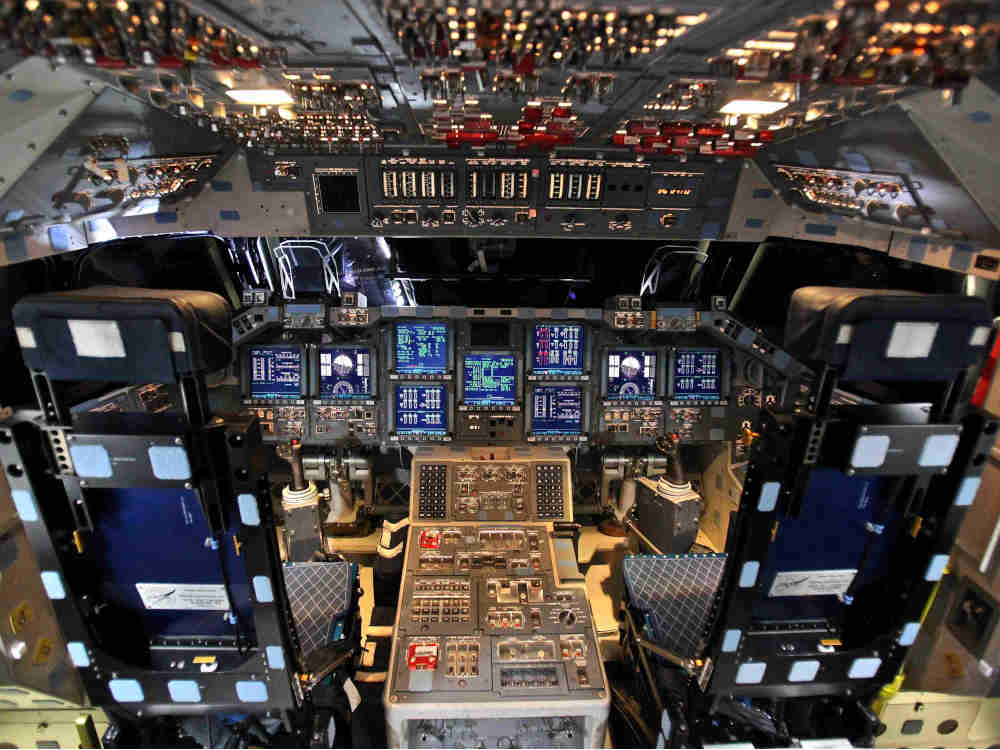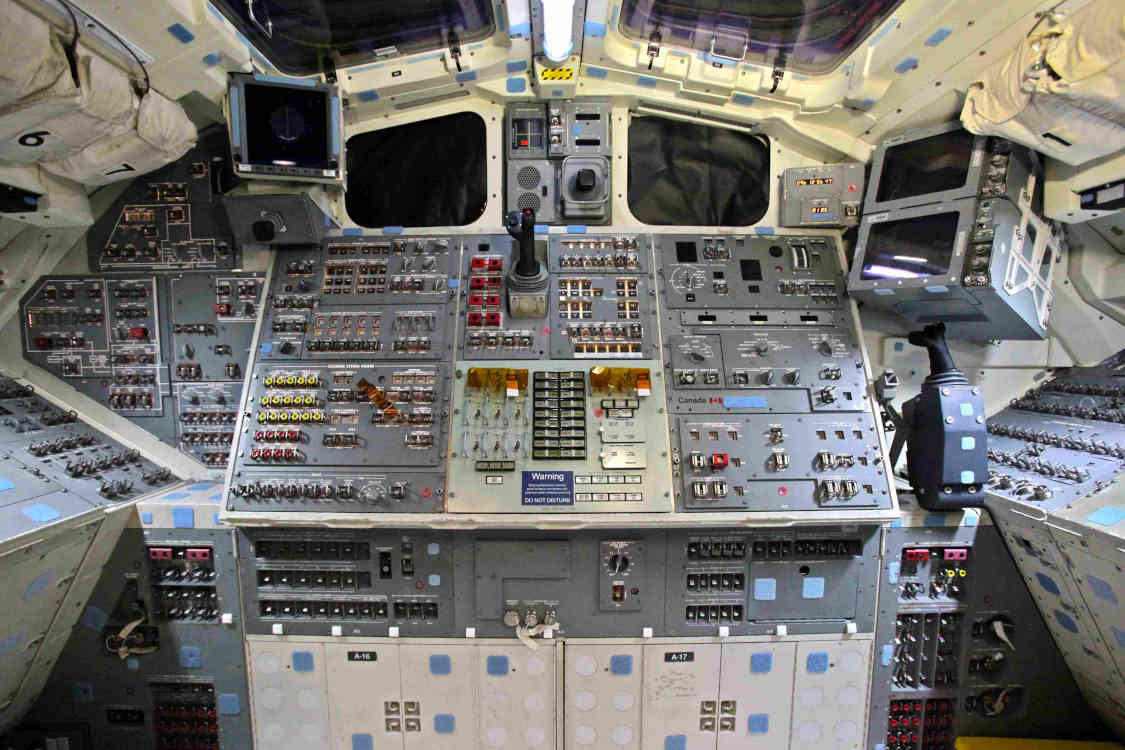WC Pablo Carlos Budassi: Halley's Comet Orbits Sun Every 75 Years Over the millennia our planet has been hit several times by asteroids and comets. There are hundreds of asteroids in the inner solar system, many of which cross the Earth's orbit. There are still many that have not been detected. The orbit of these bodies changes with time, as they are affected by the gravitational pull of other bodies and by sunlight. One day a big one will have our name on it. To destroy or deflect such a body far out in space requires resources that currently are not available, because there is no Global Space Command.
Many of the problems facing the human race are man made. As technology advances, so does the complexity of the problems. Our political systems have become hopelessly archaic, unfit for purpose. One such problem is that of space debris. There are thousands of satellites orbiting the Earth, more than half of which are no longer used. There is half a million pieces of space junk orbiting Earth, of which 20,000 are larger than a tennis ball travelling at 27 kilometres per hour. Ultimately their orbits degrade and they fall to Earth, but not fast enough. There is a growing realization that space debris hitting these satellites will create more debris, which in turn will collide and create more. This cascade of satellite and rocket parts will ultimately hit satellites containing radioactive components, which will ultimately shower down upon us all, presenting a huge health problem. There are a number of Soviet era radar satellites that fit that description.
It has become obvious for some time that almost all space debris should be de-orbited, whilst some satellites particularly large expensive ones in geostationary Earth orbit should be given an extended lifespan through refueling, but the complexity of the problem, plus the cost, has prevented few successful missions being undertaken. I have slowly realised that this is a materials science and political problem. Materials such as aerogel, used to collect cometary material in space, are very light since they are almost completely hollow. Boeing has recently announced the existence of a material similar in structure to human bone, over 99.9% void. To create a satellite de-orbit system, it would be necessary to launch a material in liquid form and squirt it into space so that it became a honeycomb in the rough shape of a sphere of say 5km diameter. It would have to be big enough to stop space debris and satellites, without disintegrating and creating more debris. Impacts would gradually reduce its orbital speed and altitude. Being so large, atmospheric drag would encourage the descent. Most of the debris and satellites embedded in it would burn up in the atmosphere during re-entry. Some could be dissolved through the use of chemicals coating the honeycomb. Such a method would require international agreement since working satellites would inevitably be brought down.
An alternative method is to design all spacecraft to be bio-degradable. The satellite, rocket stage or space station would be made from materials that would degrade when submitted to the enormous temperature fluctuations and radiation in space over time. Alternatively its materials would dissolve in released acid, or burn in released flammable gases, leaving little to return to Earth. As a failsafe, the body could automatically de-orbit once it had lost contact with ground control, either by firing its reaction control system, or deploying a solar sail to increase drag. The satellite would have to be fitted with independent anti-collision sensors and software. Such a satellite could be designed to be easily destroyed by a laser beam from a hunter satellite. Firing a harpoon into a satellite that contains hypergolic fuels is not a good idea, and neither is firing a net at a rolling, tumbling body that will only make the firing satellite do the same and go out of control. Alternatively, instead of a laser beam, the hunter satellite could employ a plasma chamber to dissolve the space debris in. This chamber could be attached to a Pulsar Fusion DFD rocket, which would provide the plasma. I seam to recall a venera probe being placed into an environmental test chamber. Later, when it was opened up, the space probe had disappeared, vaporized. There is clearly therefore a way to rid near Earth of this junk, if only we had an abundance of cheap energy in space. This method could also be used by the military to dispose of enemy satellites. The UK's National Physical Laboratory is working on dissolving printed circuit boards in order to recover electronic components and metals. There plainly needs to be an internationally recognised standard for spacecraft construction. Finding the right materials for the task is likely to be very time consuming.
In March 2021 two satellites called Elsa-d owned by Astroscale, were launched by a Russian Soyuz rocket, designed to demonstrate how a defunct satellite could be located and retrieved from space using magnetic coupling. This of course assumes that there is something on the target satellite that is attracted to magnetic fields. The mission was controlled from the 'In-Orbit Servicing Control Centre National Facility' at the Satellite Applications Catapult, Harwell, near Oxford, UK. Such coupling could not only grab the defunct satellite, but also de-orbit it using a rail gun. The opposite reactive force could be used to position the hunter satellite for its next grab. A competitor to this system is an ESA satellite called ClearSpace-1 which will be launched in 2025 to intercept and retrieve a target satellite.
With the launching of internet constellations, this proposal appears an impossibility due to the ever growing size of the problem. The hunter satellite would have to act autonomously, and be capable of refueling itself at on-orbit service stations.
The following is a paper written by me in 2013-02-22.
This paper concerns the political aspects of space research and why if present trends continue space research will become a dirty word. BIS's Spaceflight magazines US politics section is an admission that politics and space research are inseparable in these 'troubled times.'
Like Concorde, Skylon generates its own problem. Concorde generated a sonic boom that no one at the design stage took seriously, whilst nobody wanted to hear it over their territory. It was too small to carry enough passengers and fuel for long haul Pacific flights. To put it bluntly, too many people ignored reality. We have the same disease today within the British aerospace industry. REL (Reaction Engines Limited) are proposing to build 30 to 200 Skylons. Each Skylon will have the capability to operate at least one mission per day. Assuming 30 operate just one mission per week, that represents about 1500 in a year to low Earth orbit. It can be reasonably assumed that each mission will release on average one satellite into that orbit, and no doubt larger payloads into higher orbits. I understand that the PRC intends to launch at least one hundred payloads into space over the next three years. Some of these payloads will be part of the Chinese Beidou (Compass) Global Positioning System to be operational by 2020. The USA has 31 Navstar II GPS satellites in operation with nine more in reserve, whilst the EU has 4 Galileo navigation satellites in orbit and growing. Along with Russia's Glonass-K GPS constellation of 24 satellites, one wonders whether all these satellites are really necessary.
According to the video on Youtube 'How many satellites are currently in orbit video', the answer is (dated November 2010):
In orbit 13,000; functioning correctly only 3,500.
This means that about 10,000 satellites up there are now classed as space junk. Further depressing details can be found on the esa.int website and Wikipedia.com For instance there are now thought to be 150 million pieces of space debris in Earth orbit less than 1mm in size. There are 1 million less than 10mm, and 36,000 less than 100mm. All of them travelling at orbital speeds are potentially lethal to astronauts. Whilst many satellites up to 1100 km altitude can be deorbited into the Nemo spot located in the South Pacific, and those on geostationary orbit uplifted into a grave yard orbit, that still leaves many satellites awaiting a rendezvous with death.
You may think that bringing space junk back to Earth is a most intractable problem, but you would be wrong. The hardest problem of all is how to get our governments to think and act as one. By ignoring this problem the spectre of global financial collapse becomes more realistic, whilst the spectre of manned interplanetary travel unlikely.
SHUT: International Space Station and Soyuz spacecraft Left to the unrestricted laws of capitalism, the amount of space junk will inevitably reach a point where the ISS (International Space Station) is taken out, probably with the loss of all of its personnel. Recently the gloves of astronauts working on the ISS were found to be leaking. The cause was due to abrasive action between finger tips and craters made by micrometeorites on the ISS structure. The ISS coupled to Skylon presents a potentially large explosive target, since the spaceplane will retain some cryogenics in its main tanks to act as a coolant during re-entry. This could be mitigated by transferring oxygen and hydrogen to an orbital fuel dump upon reaching orbit or venting it off into space. Active cooling during re-entry could then be attained from the tankage used by the OMS (orbital manoeuvring system) which would be better protected. Probability and size of such impacts could be gleaned from the examination of data from the US space shuttle programme. The development of airframes and tankage that can survive impact by micro-meteorites and space debris, such as self repairing graphene, is essential if lengthy manned missions on space stations and to the planets are to become a reality. Realistic testing would be necessary as part of the certification process. A disaster similar to what befell the R101 airship in 1930 is not something Britain's aerospace industry needs during this period of growth in the space sector. This beggars the question, 'will Skylon operators receive the necessary insurance cover for missions to the ISS?' If the ISS is taken out do not expect the US Government to blame itself. If the BP Deepwater Horizon rig disaster is anything to go by one can expect big business to be sued left, right and centre. (BP litigation cost $9.5, clean up $37.2bn, fines $21bn approx, total $65 billion as of 2019.) First there's the junk owner, and then there's the junk manufacturer followed by the junk launch company, all of whom must share some responsibility for what has happened. In the background there are the insurance companies. The effects of this $100bn+ disaster will have implications for the space sector and insurance industry, including nation's economies in general for years to come. No government will have the courage to take on the US Government over this, any more than HMG could support BP who are still being hammered for tens of billions of dollars of compensation. After reading two sentences in the Aftermath section of this disaster on Wikipedia, I came up with my own space version.
1...Cost of litigation and damage, plus amount that can be recovered from others, are as yet impossible to determine.
2...The damage is of an apocalyptic scale, and is still on going, through a cascading effect. There is no way of determining how this incident will develop further.
3...This incident is highly complex involving hundreds (possibly millions) of satellite owners, satellite operators, and satellite users.
4...Assuming further launches are suspended, including those to higher orbits, it is likely to take at least ten years for all debris to fall to Earth. Litigation from launch companies, space ports and governments should therefore be anticipated.
5...Showers of debris will jam the signals from DRSS, ERS, TV sat, etc., resulting in further litigation.
6...This is likely to result in other competing technologies (fibre optic, aerostats, etc.) taking over, thereby making undamaged satellites in higher orbits redundant, resulting in further litigation.
7...The effect on the insurance companies involved, is as yet indeterminable.
It is thought that 30% of the global economy relies in some way upon space satellites, the loss of which will have a major impact upon stock market indices. It may well bring an end to the global economy, capitalism, democracy, as we now know it.
On the sixth of July 1988, one of the largest oil production platforms in the North Sea, namely Piper Alpha, exploded in flames killing 167 oil workers, including two rescuers. 61 survived. The disaster was caused by failed safety procedures during long term maintenance. The operator was Occidental Petroleum (Caledonia) Limited. No individual nor company was brought to court. The insurance cost was $3.4 billion (1.7 billion pounds). This is much less than the Deepwater Horizon incident, even though there was far greater loss of life, and the rig was a key oil and gas production platform pumping ten per cent of North Sea output. It clearly shows that over time, compensation culture has become more severe. It infers that next time the costs could be in the trillions.
LET THIS BE A WARNING TO ALL COMPANIES AND GOVERNMENTS OPERATING IN THE SPACE SECTOR THAT DOING NOTHING ABOUT SPACE JUNK IS NO LONGER AN OPTION. SpaceX, OneWeb and other satellite constellation launchers and operators, take note. In July 2021 the RMS (Remote Manipulating System) mounted on the ISS (International Space Station) was hit, creating a 5mm hole in the arm.
Politicians are doing what they like doing best, namely burying their heads in the sand to the problem. This ensures that the predictions here will become a reality. Who does what and who pays for it aren't even on the table, because the problem is being ignored. These problems would not exist if the human race was governed by a world technocracy. There would be no duplication of GPS constellations and no shame attached to paying for the removal of space junk. Since the collapse of the Berlin Wall, a generation of peace has seen precious little advancement towards a world order. Instead we still see sabre rattling from armed forces supported by armaments industries who plainly don't want change, so if they can't find an enemy then they will create one, motivated by job security and profit. Governments on both sides of the wall have failed to re-educate the 'masses', and whilst these petty squabbles continue the serious problems like human overpopulation exacerbated by extended life span, global warming, terrorism and proxy wars, depletion of marine life, self replicating nano-technology and of course increasing levels of space junk, all get ignored.
That however is no excuse for not putting forward recommendations.
WC Sebastian Kaulitzki: Asteroid and Planet Earth De-orbit of large space junk such as spent satellites and rocket stages would be carried out by an orbital transfer vehicle whose normal duties would be to service operational satellites, including their transfer to higher orbits as required. An OTV would also have the ability to repair and refuel satellites. OTV's would employ Gecko's. Gecko's would be mass produced in their thousands and supplied to the OTV in pallets in low Earth orbit from space shuttles. For large rogue satellites it would be necessary to use more than one Gecko for de-orbit purposes.
1...OTV's would be fuelled from surplus fuel dumped at depots by space shuttles. OTV's employ Geckos, a massed produced micro satellite with sophisticated rendezvous and latching abilities, incorporating a retro rocket that is attached inside the throat of the satellite's main thruster for de-orbit purposes. The latching ability would consist of fast reacting spider like arms similar in technology to smart prosthetics. De-orbit is achieved by direct initiation from Space Command. Satellites can be de-orbited to atmosphere. At additional cost, de-orbit via shuttle could be initiated for security, safety, insurance, reuse or heritage reasons. Remember, under international law every piece of space junk is owned by someone, whilst every satellite is a potential swarm of space junk.
2...An OTV employing a magnetic field to stop tumbling and spinning of rogue satellites is 'locked' onto defunct satellite, and then using RCS thrusters to achieve 'docking' the pairs orbit is stabilized. This would only work on satellites that were small, with no long aerials or large PVA or dish arrays and had material that would couple to a magnetic field. A Gecko is then transferred from the OTV's pallet to the satellites main thruster for de-orbiting purposes.
Another method, in the case of tumbling satellites, is to employ a web which would be shot out by the Gecko and drawn in to the target satellite as it wrapped the net around itself. Once attached to the side of the satellite it would release itself from the web, orientate itself, operate its RCS to stabilize satellite, then migrate down to the main thruster and attach itself prior to rocket motor ignition. Algorithms and sensors would be as advanced as that found on anti-aircraft missiles, if not more so.3...Whilst the use of ground based and space based chemical lasers have been proposed for the de-orbit of space junk, they are expensive, whilst the effective range of lasers is less than five miles through the atmosphere. International agreements forbid the use of space based beam 'weapons', which is why these satellites have thus far not been launched. A satellite employing a gas jet, may have the ability to slow down or even vaporize an orbiting screw, strut or fleck of paint, but such a procedure would be too time consuming. This operation would be carried out outside the altitude of most working satellites in order to prevent collateral damage. The exact orbit of these items would need to be known, probably by space based radar. The more infrastructure that is put into space, the more likelihood of generating more space debris, whilst increasing cost.
4...A series of inflatable spheres a few kilometres in diameter probably made of graphene employing a sticky outer surface or net to decelerate and ensnare small junk, possibly made of vectran. Placed in 600 to 1100km and 1400 to 1600km orbits, where space junk is numerous, they would theoretically mop up all small pieces of debris. Over time impacts would cause the spheres orbit to degrade, necessitating an attached retro rocket de-orbit the sphere in order to avoid collateral damage with working satellites.
5...If all else fails, nature in the form of a close encounter by a comet will rid Earth orbit of satellites and space junk, to be replaced by cometary debris.
6...Of course it would be great if these satellites could withstand high velocity impacts. In the UK Synbiosys has developed a ceramic sandwich designed to convert such an impact into thermodynamic energy which can be quickly dissipated. Such a material could protect the huge structure of Skylon in space, as well as space stations.
6...Safe destruction of satellites in orbit, is easier said than done. The satellite would preferably be designed to self decay. However, users and insurance companies would probably highly disagree, since it would be difficult to determine the satellites lifetime. Alternatively, an OTV with stand-off Gecko, could rendezvous with the target and squirt a sticky rubberized substance at it containing a corrosive or solvent liquid. The satellite would be designed to dissolve safely, once enshrouded by the substance. Later the 'thing' would dissolve safely due to exposure to sunlight, or some chemical reaction. This is plainly a highly advanced project for chemical scientists. For instance, the 'thing' could crawl around the satellite by employing fungi or other such extremophile.
There are many ideas like these on Wikipedia. Harpoons could not be used on dead satellites as they may cause explosion of pressurized tanks, creating more debris. 240 explosions have already occurred in space creating 50% of space debris. The use of a sling-sat sounds appealing because it requires minimal fuel for de-orbit, however, satellites are not designed to be slung around particularly at orbital speeds which are likely to lead to break-up and hence more space debris.
Whilst a limited international agreement exists designed to reduce the production of space debris, it is limited. Currently satellites should be de-orbited within 25 years of end of life. However this UN agreement makes no allowance for all the satellites that could be launched by vehicles such as Skylon within those 25 years. The destruction of Feng Yung 1C weather satellite by its owner, the PRC, in January 2007 at an altitude of 862 km by a surface launched missile, clearly shows just how respected this agreement is. At least 2500 pieces of space debris was generated, much of it posing a threat to China's manned space programme for decades to come. With no explanation and no apology, one wonders when and from where the next blunder will come from. As many nations have learned to their cost, space research works best under an umbrella of international co-operation, unless of course one requires a space race.
With the PRC determined to plant its flag on the Moon and probably on Mars, can western governments afford to ignore this issue? It's plainly obvious that capitalism needs a real boost, and for the UK that won't come from the proposed 140 mile long, 106 billion pound, HS2 railway from London to Manchester and Leeds, plus the 24.5 billion pound operating costs and subsidies over 67 years. Living in Birmingham I can't even afford to use Virgin Trains to get to London, which I have not visited for over thirty years. I seem to recall the Reaction Engines Limited website estimating their Project Troy manned mission to Mars costing around 75 billion pounds. That's chicken feed compared to the 375 billion pounds handed out by the Bank of England in quantitative easing, and where has it got us? Even HS2, London to Birmingham high speed rail link, is estimated to cost more, and what green shoots will come out of that? Of course once the main lines have been built, the feeder tracks will have to be upgraded also, at additional expense. By which time it will all be regarded as a museum piece. The only reason HS2 is being built, is because most developed countries have their high speed trains, and the British establishment wants to be part of the club. Well it won't be part of the club because the goal posts are moving. Japan's Chuo Shikansen maglev line from Tokyo to Osaka will be 178 miles long and initially cost £63.9 billion. The train will travel at 600km/h. Now that will compete with air taxis.
With the PRC being constantly accused of hacking US computer centres it's unlikely that Skylon will find a market there. And would Skylon be sold to say India if it appeared likely that the nation would use it to launch Russian military payloads? The market for Skylon appears very limited in the present political and economic climate. However, its basic design does lend itself to being scaled up to handle larger payloads, something which an aircraft launched Skylon would not. Since NASA is going for a 70 to 140 ton payload capability with its SLS (Space Launch System), the latter presumably to carry nuclear reactors to power the ion thrusters of a manned interplanetary vehicle or base on the Moon or Mars. It beggars the question, can Skylon be scaled up to do something similar. It's likely that the oxygen and hydrogen tanks would not require active cooling during re-entry were they to be made from carbon nano-tube material or similar. Such a carbon based airframe/thermal protection system could be made employing 3D printing machines, with the main axis of the spaceplane being of vertical orientation during manufacture. The hull could consist of three layers, like that of the Airlander 10 airship, with sealant on the inside, structural layer in the middle and thermal protection on the outside. This technology would be required to build large commercial airliners especially of blended wing design, and would therefore qualify for government grants. This technology could also be employed to build a lighter pre-cooler for the SABRE (Synergetic Air Breathing Rocket Engine), plus honeycomb structures in areas such as compressor, undercarriage struts, brackets and fastenings.
WC NASA: Space Shuttle Orbiter Illustration WC NASA: Space Shuttle Flight Deck WC Steve Jurvetson: NASA Space Shuttle Cargo Handling Controls It's likely that large payloads like those for the SLS would still require assembly in space. Hence the need for an advanced remote manipulator system and space-dock.
I do not subscribe to the idea that Skylon is being developed at a reasonable rate. Sir Frank Whittle took fourteen years with the jet engine, from patent to active service. That was an age before CAD/CAM, parameterization, BOM (Bill of Materials from attributes), FEA (Finite Element Analysis of materials), CFD (Computational Fluid Dynamics of gases and liquids), dedicated heat exchanger thermodynamics design software, 3D printing and advanced materials research. Having worked as an engineering design draughtsman at Serck Heat Transfer's Tubular Cooler Division, I am sure it will not take much effort for the USA, PRC and Russia to come up with their own Skylons, initially for military purposes. If that were allowed to happen, where would LAPCAT and the European Airbus consortium be then? Most profits from any project usually go to those who bring it to market first, although the De Havilland Comet is an exception. HMG and REL must instil a sense of urgency into this venture. Designing SABRE to the nth degree is not desirable in the early phase, since to do so holds back progress in areas of OTV, SUS, space-dock, RMS and robotics, all of which should be tested during the x-spaceplane phase (boilerplate), which itself will not be perfect.
As REL now looks around for the $500 million it needs to cover the cost of testing the nacelle and a scaled down SABRE engine in the atmosphere, plus further development of the Skylon Upper Stage (SUS), deep thought should be devoted to the details of the next stage. Namely, how to gainfully employ Skylon during the 200 to 300 missions that the two x-spaceplanes will be devoted to. Every mission should have a public relations slant. These missions will fall into three areas of use:
1...Satellite launch into Low Earth Orbit, and Geostationary Transfer Orbit using SUS.
2...Space station support, sixteen missions by Skylon are scheduled to go to the ISS.
Further missions could be devoted to the support of an REL inspired space hotel or support for Excalibur Almaz (capsule & space module) or Bigelow Aerospace (inflated modules). Such a space hotel complex should have a truss for the attachment of long stay payloads, in order to reduce the number of individual satellites in LEO. The supply of two accommodation modules to the ISS as a means of the UK paying for manned missions has already been proposed by REL. Based upon criticism by cosmonauts, it is clear that shower facilities should be included. Ideally, toilets, showers, filtration, recycling and hydroponics should all co-exist in the same module. Skylon's 4.6m diameter x 12.3m long payload bay could also demonstrate its manned orbital capabilities through ESA's Spacelab.3...The recovery of space debris. As with the handling of nuclear waste, disposal will not be easy nor cheap, but it will be far more cost effective by employing a reusable space shuttle. It is time for REL to bite the bullet where no space agency has had the guts to. This is how to make friends and influence people. The long term returns could be substantial.
These should be high profile missions in order to get as much publicity as possible, in order to attract future investment when the time comes. The thought of building a mock-up of the ISS, in cheap materials, so that prospective customers could compare construction times, did occur to me, but the conclusions might prove too embarrassing to some. A mock-up of Project Troy in LEO would certainly inspire the young, but no doubt be regarded as a frivolous waste of resources by others. It could however be incorporated into a British sci-fi movie. It would however pose a serious test of Remote Manipulator System (RMS) assembly techniques, the hardware presumably from Canada. I do however feel that cryogenics should give way to plasma drive for two reasons. The latter is faster thereby reducing mission time to Mars and hence less bio-degradation of the crew, whilst being compact with less volatiles, it is easier to shield against space junk and micro-meteorites.
Publicity and a public relations manager are pre-requisites to running a successful business. They require an up to date web site and a portfolio of proof read scientific papers on this project in all main languages for prospective investors and customers to read, before they are likely to take REL and other seed companies seriously.
SHUT: Two astronauts in Extra Vehicular Activity at ISS
A target for radiation, micrometeorites, space debris, and they know it.According to the data in Spaceflight, there were 146 satellites/missions launched from October 2012 to September 2013 editions, of which 12 missions were to the ISS, whilst 75 I considered likely to be launched by Skylon. There were 11 Russian, 11 USA and 16 PRC satellites likely to be launched indigenously due to security and prestige reasons. The total includes about 30 mainly American micro-satellites (cubesats) which I regard as satellites of opportunity and of little financial reward to Skylon operators. Some rockets launched more than one satellite making the total number for Skylon contentious. With higher data rates likely in a future fibre optic internet, plus advances in solar powered UAV relay stations, it is likely that we will see a reduced number of communications satellites launched in the future. There is currently an insufficient number of civilian payloads to justify the development of Skylon. Without ESA members embracing manned missions into space I can see ESA becoming a has-been space agency representing a stagnant economic backwater of the global economy, with REL ultimately relocating to the United States, rather than face nationalization, as happened to Sir Frank Whittle's Power Jets.
Meanwhile, competition from ESA's Vega, Ariane 5/6, Space Adventures (spaceflights to ISS), Space-X (Dragon space capsule), Sierra Nevada Corp. (Dreamchaser space shuttle), Boeing (X-37 OTV), Xcor Aerospace (Space Expedition Corporation Lynx spaceplane), Virgin Galactic (Spaceship Two), NASA's Orion and Russia's Soyuz is not likely to go away, for prestige reasons, not to mention the replacement Soyuz (Energia 4 man capsule), Swiss Space Systems Dassault Vehra air launched lifting body and finally the Japanese JAXA space agencies Epsilon satellite launcher which was first launched in September 2013, are likely to remain a thorn in Skylon's side for years to come. Change in mindset does not come swiftly. Space agencies and their associated launch systems are status symbols first and security agencies second. Their operations have little or nothing to do with the laws of economics.
I can therefore see a market for no more that five Skylon's. However, there appears to be a market in the military field as a replacement for the Trident SLBM system. As a launcher of smart munitions, targets could be taken out with little or no warning by a combination of conventional and nuclear warheads, the latter being sub-orbital so as not to violate SALT agreements. The Skylons could be commercially owned and operated, thereby dramatically reducing costs. The 1kt say nuclear missiles, would be kept in military bunkers right up until the moment of use, whilst the delivery system can be kept in variable orbit whilst carrying conventional or AI weapons. This is plainly not MAD, since collateral damage would be far less than that from a Trident system. Communications and hence reaction times would be swifter, supported by a plethora of military intelligence/communications satellites also launched by Skylon. Such a system could be used to take out terrorist groups, drug gangs, and pirates in countries where the police and military are ineffective, for a fee. This system is more politically acceptable to the times in which we are living. Nuclear SLBM submarines on the other hand are very large and slow, and dedicated to one type of mission only, that of global thermonuclear war. They are susceptible to detection from advanced sonar and radarsats, whilst these methods of detection limit them to a small area of ocean (Sargasso Sea and polar ice cap), as demonstrated by the near apocalyptic collision between two UK and French vessels in February 2009. Communications with such vessels by ELF and VLF is slow and one way only, whilst using a near surface buoy for higher frequencies risks detection by satellite.
It is my bet that Skylon's forte lies in the support of manned missions. HMG's UK Space Agency could use Project Troy as a catalyst designed to stimulate the minds of British management, seed companies and ultimately the economy via a higher and hence more competitive technology base, enhancing the UK's reputation abroad. Develop an idea for this project and you will receive sponsorship, government contracts, R&D support and tax breaks. Don't support this project and large companies will pay a one off levy based upon their turnover to finance it anyway. As for multi-nationals operating through the internet, they should be taxed on their sales turnover in this country and no other way. As for income tax, it should be set at a realistic level. Back in the 1960's it was at 90%, you went to bed with a hot water bottle (no central heating), slept between damp sheets and woke up to windows frozen on the inside. Then of course there was the outside loo, full of spiders. This was not austerity, as the prime minister would remind you 'you've never had it so good'. The alternative is to go beyond capitalism.
Without a doubt Skylon is an ideology too soon. To make it work in a responsible way one needs a world technocracy, but unfortunately there is no way of creating one. The UK needed a technocracy in the 1930's to stand up to fascism. Today we have politicians that don't even want reform of the House Of Lords and an electorate that doesn't even want US style mayors in order to get things done faster. Too many jobs rely on conflict. There appears to be no incentive to create a world order and a science based society. As for interstellar missions, JBIS contributors, you have a very long wait indeed. Such missions await a new form of propulsion and of course a confirmed destination to go to. The latter is likely to be provided by huge space based telescopes launched and assembled by Skylon? I cannot help thinking that Alan Bond & co. would be better employed if they launched themselves into politics as independent technocrats. Employing a majority of such members, a surgical strike could be inflicted upon our outdated unwritten constitution, replacing it with a technocracy.
Currently the Skylon project is under review by ESA, who wish to know who will buy 100 to 300 Skylons. The answer to this question will be largely irrelevant. At stake is ESA, not just Skylon. Its members have to decide whether ESA is to embrace a long term manned space program using the most affordable space transportation system they are ever likely to have, namely Skylon, or become a third rate agency. It needs to justify the huge investment needed. It is plainly not just a satellite launcher. For those working in the launcher business it is a harbinger of doom. Thousands of people will lose their jobs, particularly in France and Germany. So what is the solution. The solution is for ESA to boldly go where ESA hasn't gone before. With NASA hell bent upon going to Mars, for ESA to stay at home would be an ignominy too far. Clearly there would be work for all of its members, particularly in the areas of OTV and space-dock, not to mention the interplanetary spacecraft itself, rather than waste resources on more expendable launch vehicles. It's time for those in the mollycoddled launcher business to visualize the new and embrace it.
Skylon of course would also be the test bed for the EU's LAPCAT hypersonic four Scimitar engined airliner. LAPCAT is a derivative of Skylon and its two SABRE engines. Without Skylon it is unlikely that the EU will ever build a follow-on from Concorde. What future then for the European Airbus consortium?
Skylon is one of HMG's advanced projects designed to boost the economy, but then so was Black Arrow and its satellite Prospero in 1971. Symbolically, Prospero is now a piece of orbiting space junk. Will Skylon go the same ignominious way as UK based research into the jet engine, radar, 3D colour television in 1944 and more recently TFT's (thin film technology)? It's now time to support Skylon. I've bought mine from the BIS. It's time you bought yours.
I've also got my free Skylon shoulder bag from REL at the Farnborough Airshow. It's a great time to be a space enthusiast. Incidentally, the word Skylon comes from the fuselage shaped 100m tall modern art displayed at the Festival of Britain, on the banks of the River Thames, London in 1951. The joke then was that like the economy it had no visible means of support. This nation has endured monetarism for over 30 years in which one government after another has agreed to import products rather than manufacture them here. To make things appears to be totally alien thinking to many in HMG these days. This is what happens when a nation doesn't make anything important anymore.
References:
1...JBIS Vol. 63 No 4 Skylon Infrastructure
2...Spaceflight Vol. 52 No 11 Spotlight on Skylon
3...JBIS Vol 61 No 10 The Skylon Spaceplane: Progress to Realization...The Habitation Extension Module (for ISS)
Ideas 17...Asteroid, Comet & Space Debris

--== Skylon, An Ideology Too Soon? ==---

It is only a matter of time before collisions between satellites and space junk create a self perpetuating cascade that makes all operations in Earth orbit so dangerous as to be impossible. By then there will be so much junk that it will be impossible to remove it. As a result all space related ventures will cease. There will be no global mobile communications, no GPS for guided munitions and autonomous road vehicles, no TV /internet for remote regions, no new Earth resources data, no monitoring of volcanic and earthquake zones, no military intelligence and most important of all, there will be a marked drop off in international co-operation.





